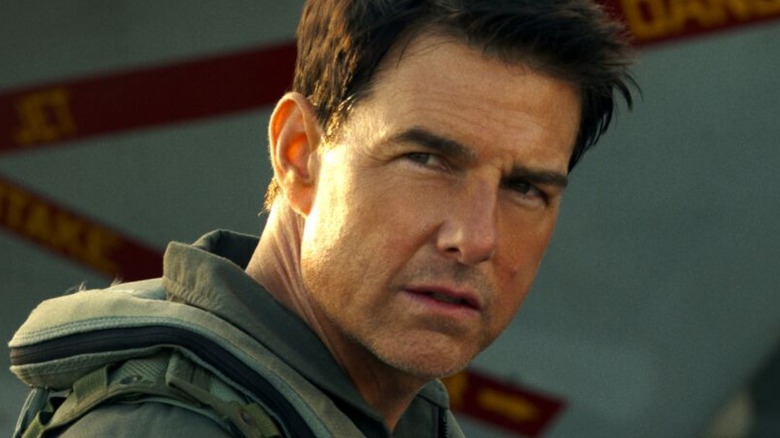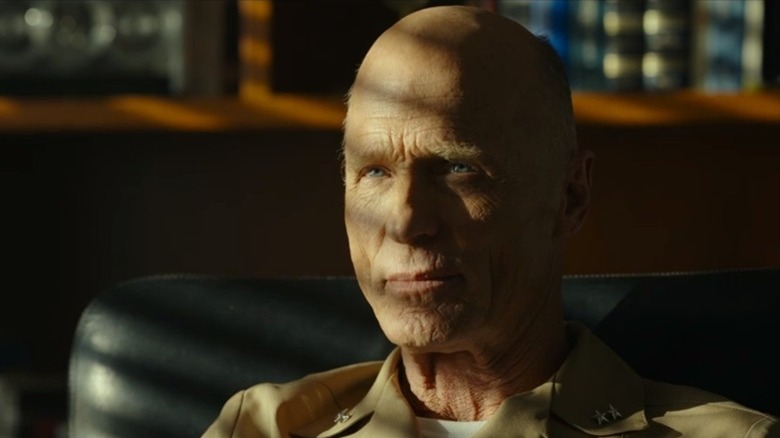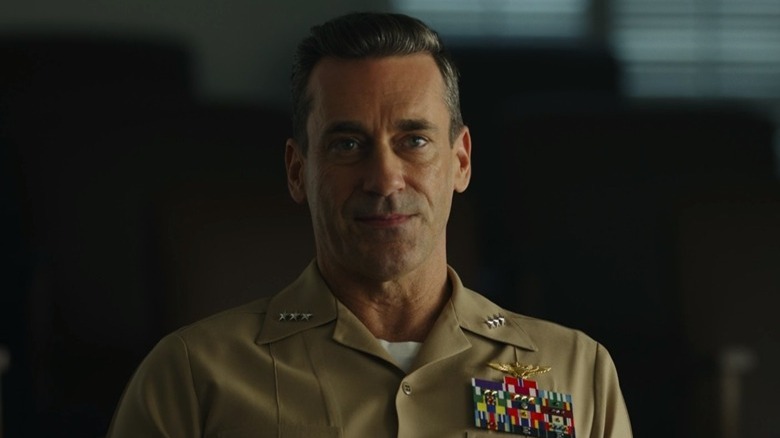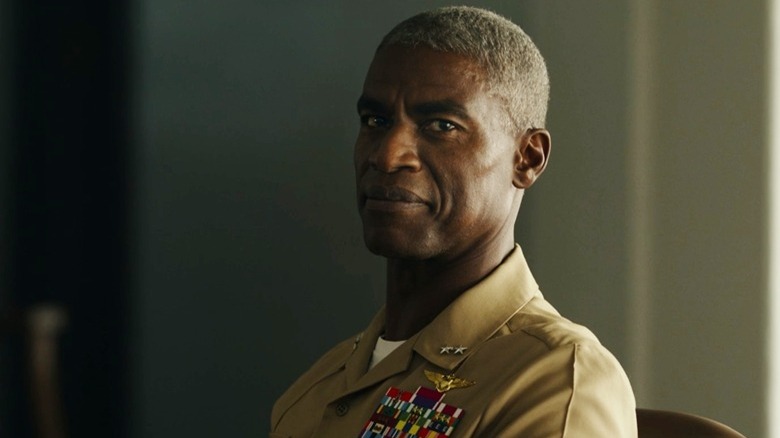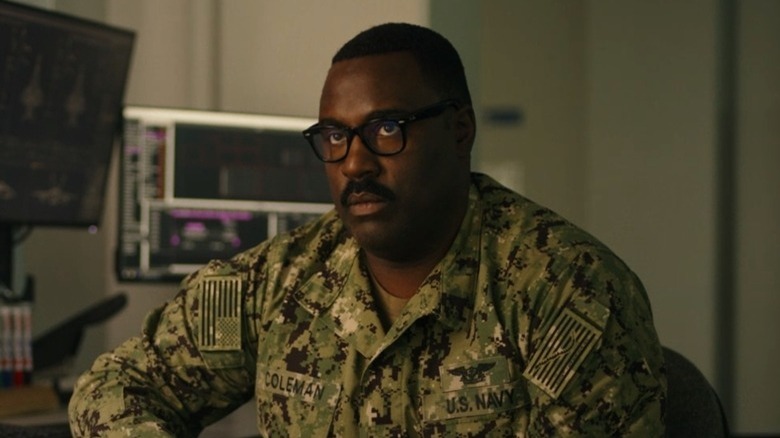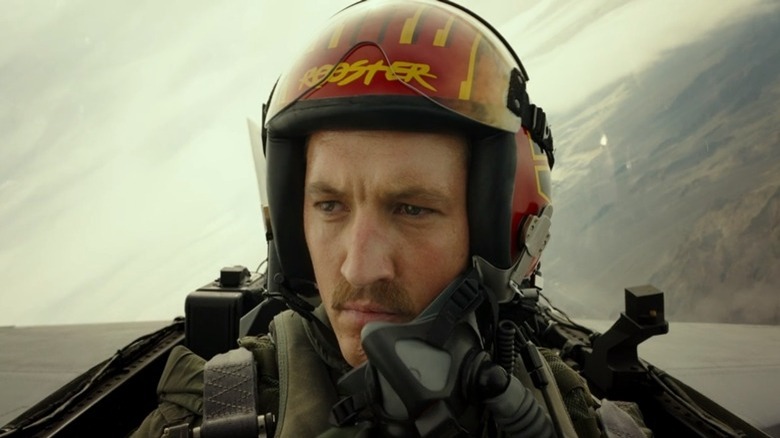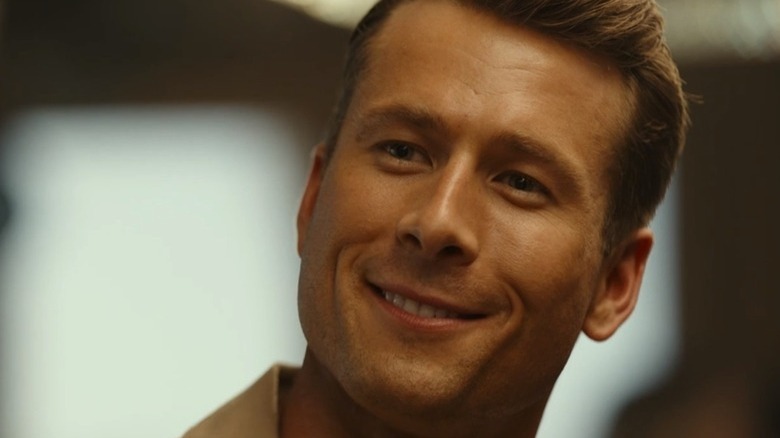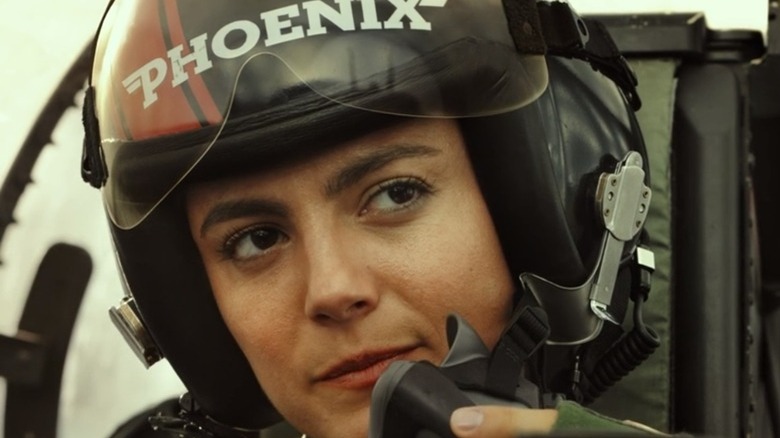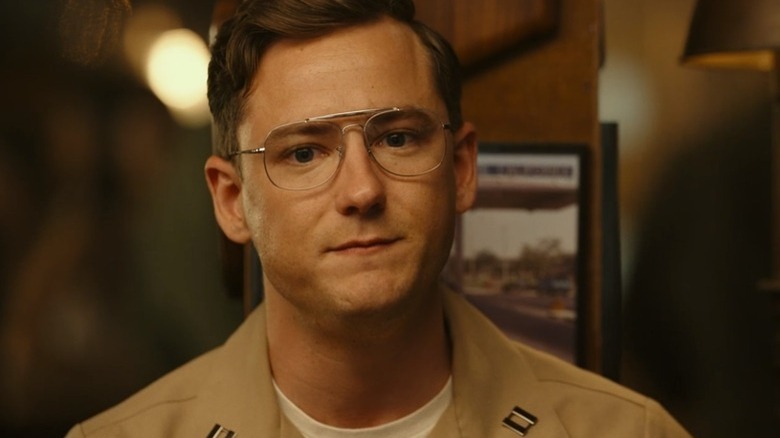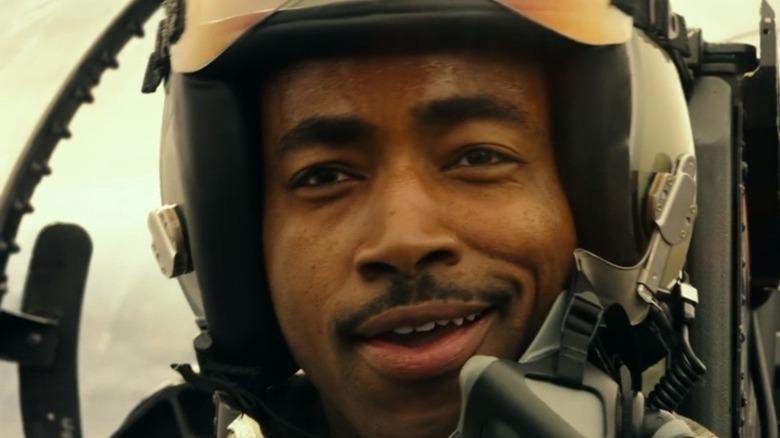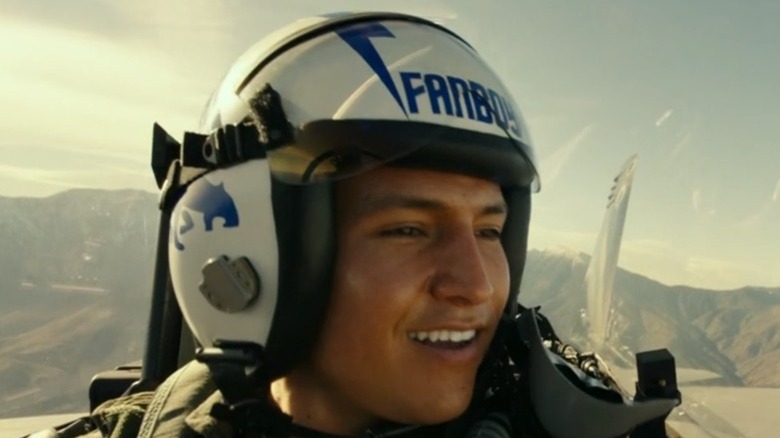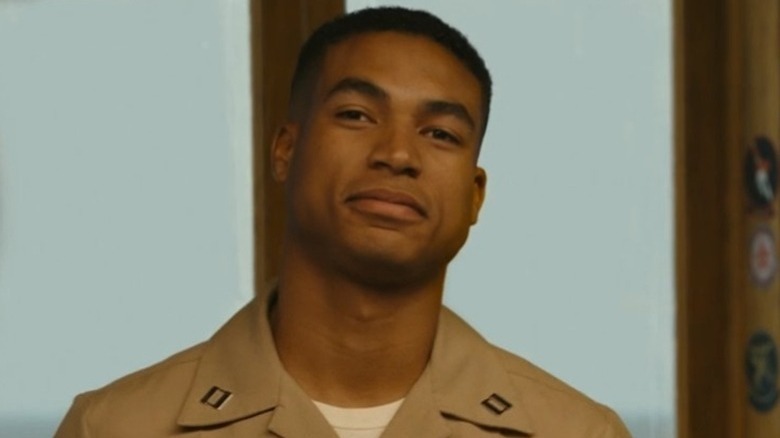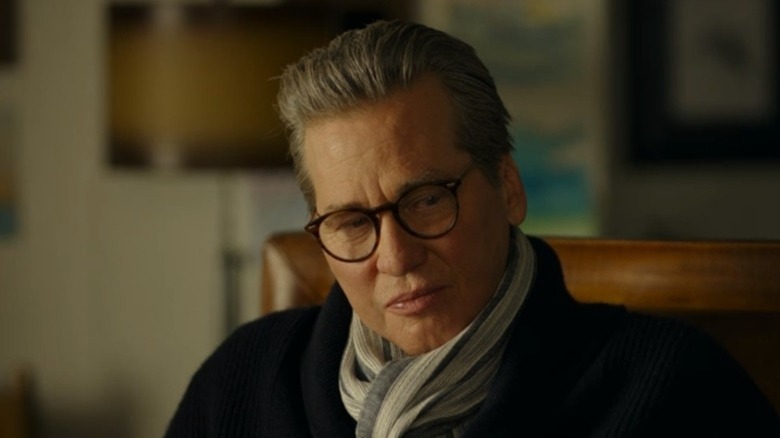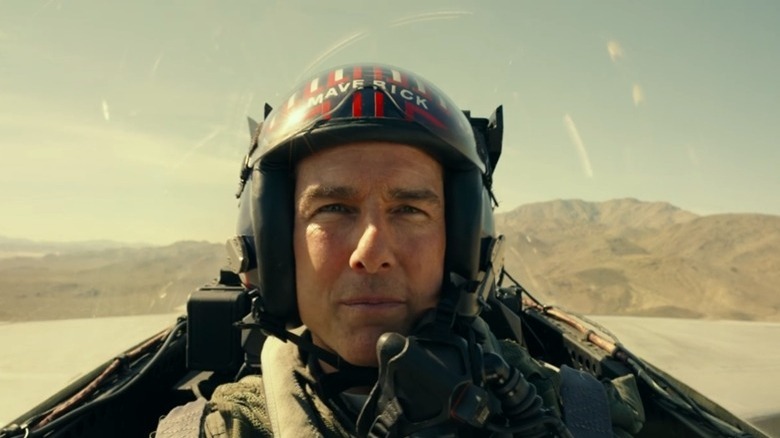Every Top Gun: Maverick Call Sign Explained
"Top Gun: Maverick" turned out to be the surprise success of summer 2022. While the original was undeniably popular, it was also over 36 years old by the time "Maverick" hit theaters. Nonetheless, this intergenerational sequel scored some of the best reviews of the year from critics and viewers alike, and lit up the box office all summer long. For over four months, it maintained cruising altitude in the top 10 highest-grossing films each week on its way to over a billion dollars in ticket sales.
What's the secret to its success? Well, it obviously never hurts to have Tom Cruise, one of America's most recognizable movie stars more than 40 years into his career, as your headliner. Backing him up with a mix of established actors like Val Kilmer and Jennifer Connelly and rising stars such as Miles Teller and Danny Ramirez almost certainly helped as well. Sprinkle in some incredible practical effects, an emotionally resonant script, and audiences looking for a reason to go back to theatres, and Paramount Pictures had a powerful combination of factors for success.
However, there's one more little aspect that makes "Maverick" engaging, and it's right there in the title: call signs. It may seem minor, but there's no denying the excitement of a story where characters answer to names like "Halo," "Omaha," and "Yale." But what inspired these cool call signs? Let's take a look.
Ed Harris as Rear Admiral Chester Cain, aka Hammer
While Ed Harris' Admiral Cain is only briefly on screen, he makes his presence felt. Initially entering Captain Pete "Maverick" Mitchell's life as the man trying to shut down the test pilot's project to perfect a jet capable of flying Mach-10, he seemingly gets outplayed. Maverick gets off the ground before Cain's arrival and hits Mach-10 successfully, while Cain can do nothing but observe from the Command Center. Unfortunately, Maverick's success is short-lived as he loses control of the aircraft and crashes rather spectacularly.
Still, Mitchell's guardian angel, former rival turned friend Admiral Tom "Iceman" Kazansky, intercedes on Maverick's behalf. Iceman gets his friend a gig training young pilots for a dangerous mission at Top Gun Academy, delaying Maverick's honorable discharge once again.
Despite his foiled plans, it is still easy to see how Cain earned his call sign. He is a man who strikes fast and efficiently. His presence makes an immediate impact that is impossible to miss or ignore. So while Maverick may have gotten lucky this time, it's clear Cain is a man who usually hits his target and eliminates them in one clean stroke.
Jon Hamm as Admiral Beau Simpson, aka Cyclone
Initially, Jon Hamm's Admiral Simpson seems a strange figure to wear the call sign Cyclone. Immediately skeptical of Maverick, Cyclone presents as a serious man who makes tough decisions but has no use for risks or flaunting the rules. While Rear Admiral Cain may be the antagonist who sets the film's plot in motion, Simpson is the more frequent thorn in Captain Mitchell's side. Everything about their interactions makes it clear that Cyclone is waiting for Maverick to fail from the moment the Captain pulls up at Top Gun on his motorcycle.
However, as the film progresses, there are hints of how Cyclone earned his call sign. For one, the audience learns he was number one in his Top Gun class. In addition, the film's emphasis on instinct and doing the right thing over the prescribed method suggests that Cyclone didn't always grip the rulebook quite so hard.
Second, Cyclone eventually relents. Despite the idea that including Maverick in the mission seems like a significant risk, he makes the call to let Captain Mitchell lead it. Additionally, he chooses Maverick's "less likely to succeed but more likely to get everyone home if it does" strategy for the mission over his own higher probability of success-despite-casualties plan. Cyclone may be a stickler these days, but there are obviously still some wild winds in his heart.
Charles Parnell as Admiral Solomon Bates, aka Warlock
As the other Admiral overseeing command of the film's training and mission, viewers never get to see Bates in the cockpit of a fighter jet. However, given his leadership style, there's plenty of evidence as to what earned him the call sign "Warlock." For one, Warlock implies a certain wisdom or access to information and abilities that not just everyone has. Given his ascension in the ranks of the Navy, it seems clear that Admiral Bates must have been a skilled and intelligent pilot turning his time at the stick of a fighter jet.
There's also the fact that he's helping lead a mission that seems nearly impossible and yet still ends successfully — and with zero casualties. That's a kind of magic. Even more magical, he manages to navigate the complex and none-too-small egos of Cyclone and Maverick, getting them to work together no matter how strenuously they object to doing so. That kind of interpersonal spellcasting earns you the call sign "Warlock."
Bashir Salahuddin as Chief Warrant Officer Bernie Coleman, aka Hondo
Chief Warrant Officer Coleman comes over from the scramjet program with Maverick to aid in the film's mission. Having worked with Maverick for some time, Coleman is the Captain's biggest booster from the start, the one person besides Iceman who seems to believe that Mitchell is the right man for the job.
While no specific reason for the Warrant Officer's call sign of Hondo ever comes up in the movie, a look at the word's meaning in other languages offers significant insights into why he wears it and wears it well. Honshu, the largest island in Japan, has historically been known as "Hondo" (per Britannica), lending the name a sense of stability and significance. In Spanish, meanwhile, "hondo" means "deep" or "profound" (per Collins Dictionary). Salahuddin's performance gives Coleman those qualities whenever he's on-screen. Even goofing it up during the beach football game, the sincerity of his actions is apparent. His depth of character and thoroughness are evident throughout the film, too.
Miles Teller as Lieutenant Bradley Bradshaw, aka Rooster
Miles Teller's Lieutenant Bradley "Rooster" Bradshaw begins training as the only young pilot who knows Maverick. In fact, the two used to be quite close. Bradshaw is the son of Maverick's deceased wingman Nick "Goose" Bradshaw. He's also Mitchell's godson. However, after Maverick decided Rooster wasn't ready for a big step in his career and thus set the Lieutenant's progress back years, the two had a falling out, and haven't spoken in quite some time.
Obviously, the Lieutenant's call sign is an homage to his slain father, maintaining the Bradshaw family's bird motif. But it's also, subtly, a reflection of Maverick's influence in his life. Roosters aren't just birds; they are birds typically seen as being in control of situations. The most common image of the rooster is that of the bird whose cry announces morning and signals to a farm that it's time to get to work. Additionally, roosters walk with a strut that often has a certain air of arrogance to it. Being out in front of the action and doing so with great confidence are certainly Maverick-esque qualities.
Thus, subconsciously or not, Bradshaw's call sign reveals he is both his father's son and godfather's godson, a pilot who has the capacity for both of their best qualities, even if he is still struggling to find the right balance between them.
Glen Powell as Lieutenant Jake Seresin, aka Hangman
While decidedly not the same as Maverick was during his Top Gun days, Lieutenant Seresin does, in some ways, recreate with Rooster the Maverick-Iceman dynamic. Seresin is the flashier, more confident pilot, seemingly more interested in individual glory. Rooster, on the other hand, shows more caution — perhaps too much — and is a far better team player.
As Powell revealed to CinemaBlend, the script featured an even more aggressive call sign for the Lieutenant to match his antagonistic demeanor. However, when on-set military consultants suggested that "Slayer" more closely resembled the Air Force's approach to call signs than the Navy's, Powell rejected it and began to develop his own. Working together with director Joseph Kosinski and screenwriter Christopher McQuarrie, the trio hit on "Hangman." Powell told Jimmy Kimmel that a specific pilot with the call sign "Noose" was evidently a significant inspiration.
Besides the obvious deadly connotations with the name "Hangman," the script offers another reason Seresin's fellow pilots may have been happy to refer to the pilot by his call sign. As Lieutenant Natasha "Phoenix" Trace explains, the nickname also reflects Seresin's reputation for being only out for himself. If one is out flying with the arrogant pilot, they should be fully ready for him to leave them hanging the moment he has a chance to achieve individual glory.
Monica Barbaro as Lieutenant Natasha Trace, aka Phoenix
While call signs are sometimes based on city names — Jack Schumacher plays a prospective pilot who doesn't make the cut called "Omaha" — there's no evidence to suggest that Lieutenant Natasha Trace's call sign refers to Phoenix, Arizona. However, Barbaro has made comments suggesting it referred to the mythical bird. She may have even earned the name off-camera, bonding with her co-stars during nights out. "I had a pretty intense night of frivolity, we'll say," she told The Hollywood Reporter, "and I rose from the ashes the next day."
Of course, the character of Trace has likely risen from much more serious ashes than a night out with colleagues to soar once again, and likely did so on multiple occasions. Given that the Navy only began allowing women entry into the Top Gun academy in the '90s (via The Washington Post), it seems likely that Trace encountered all manner of systemic and personal barriers on her way to earning her wings. In that light, what better call sign could she have chosen?
Lewis Pullman as Lieutenant Robert Floyd, aka Bob
As the owner of the least badass call sign of them all, Lieutenant Robert Floyd understandably comes in for some ribbing by his fellow pilots. His reaction — or rather, lack thereof — reveals one possible reason he may have simply stuck to his own name for his call sign. In a field often defined by arrogance and showing off, the Lieutenant has elected to be quiet and composed while getting the job done. No matter how his fellow pilots hassle him, Floyd seems unshakable, a fine quality to have in a fighter pilot. He chose Bob because that's who he is. He doesn't need to take a nickname like "Hellfire" to prove his abilities.
In talking to the New York Times, Pullman also points out how the call sign acts as a litmus test for those around him. Given how others react to "Bob," Floyd can gauge what kind of person and teammate they are. While they are attempting to "read" him, they end up telling him everything he needs to know about them. Hence why he gravitates more towards the thoughtful and cautious Rooster while steering clear of the arrogant and dismissive Hangman, who speculates that "Bob" is actually an acronym for "Baby on Board."
Jay Ellis as Lieutenant Reuben Fitch, aka Payback
Lieutenant Reuben Fitch's call sign is as close to a platonic ideal of a nickname that someone in the military could ask for. But "Payback" isn't just about taking revenge — Fitch doesn't want to feel like he owes anyone a favor for them helping him out. In other words, he always pays them back as quickly as possible.
Ellis also joked with Insider that he put the name into practice after playing a prank on co-star Lewis Pullman. As in the film, the watering hole the cast frequented had a rule about cell phones on the bar. So one night Ellis got a hold of Pullman's phone and put it on the bar, getting the actor on the hook for a round of drinks for everyone in the establishment. However, like his character's call sign, Ellis made sure to get Pullman the money he spent. Ellis, you see, made sure to pay back all that was owed.
Danny Ramirez as Lieutenant Mickey Garcia, aka Fanboy
A hint to the reasoning behind Lieutenant Mickey Garcia's call sign can be seen every time Garcia climbs into a cockpit. Like the rest of his fellow pilots, his call sign, "Fanboy," runs across the top of the helmet just above the visor. However, if one takes a closer look, they'll likely identify something that sets his helmet apart: the font. Real-life fanboys and sci-fi enthusiasts will likely recognize it right away. While other pilots have their names written in a variety of scripts, Garcia's is very specifically the same font used for the titles on the classic episodes of "Star Trek."
Of course, not all fanboys are specifically interested in science fiction or fantasy. Anyone enthusiastic about elements of pop culture — be they video games, comics, music, or more — can lay claim to the title. While director Joseph Kosinski reportedly intended Fanboy to be of the classic sci-fi stripe, Ramirez expanded his character's areas of interest. As he told Jimmy Kimmel, he decided Garcia was likely a music guy, specifically a music guy into the vocal styling of the likes of the Jonas Brothers and BTS.
Greg Tarzan Davis as Lieutenant Javy Machado, aka Coyote
"Coyote," Lieutenant Javy Machado's call sign of choice, seems like a fantastic name regardless of backstory. Much like college mascots, choosing a cool natural predator for a call sign is an easy move. However, both Davis and the script invest more in the call sign than just the "choose an awesome animal" avenue.
As Davis revealed to ComicBook.com, he immediately noticed that Machado chose Coyote as opposed to the bigger canine predator, the wolf. This put the actor in the mindset that Machado saw himself as an underdog. Therefore, the pilot likely acted accordingly, working longer and harder than many of his peers.
The events of "Top Gun: Maverick" seem to bear out this interpretation as well. During a critical scene, the Lieutenant loses consciousness due to G-force pressure, his jet cresting and then beginning a dead drop towards the ground below. The pilot regains consciousness far closer to crashing into the ground than anyone could be comfortable with, and pulls up just in time. It's the kind of thing that would shake just about anyone, including fighter pilots. Nonetheless, Machado recovers and is back at it the next time the team goes into the air to practice for the mission. Like his namesake, he's a scrapper who refuses to go out easily.
Val Kilmer as Admiral Tom Kazansky, aka Iceman
To understand Admiral Tom Kazansky's call sign, viewers need to look back to Val Kilmer's performance in the original "Top Gun" from 1986. In that film, Kazansky is the rival of Tom Cruise's Pete "Maverick" Mitchell in the battle for best in class. Like Maverick, Kilmer's character was an exemplary pilot who was well aware of his talent. Unlike Mitchell, though, Kazansky valued the team. He might have wanted to lead the pack, but he still saw value in the pack as a whole.
Additionally, Kazansky was always a man of control. He largely maintained his emotions and composure, regardless of the training mission or interactions with others. As a result, he was cool under pressure. For keeping it under control in and out of the cockpit, the pilot more than earned the call sign Iceman. That composed attitude seems to have continued after graduating from Top Gun. As a man who projects cool confidence, his demeanor clearly made others see him as a natural and reliable leader. As a result, he ascended to the rank of Vice Admiral and served time on the Joint Chiefs of Staff. People like a man who stays calm under pressure to be in charge, and Iceman has always been that.
Viewers also see it in how he treats Mitchell now. Kind, thoughtful, and still, he helps shepherd his more emotional friend to the hard but inevitable decision Maverick must reach.
Tom Cruise as Captain Pete Mitchell, aka Maverick
While Tom Cruise's Captain Pete Mitchell certainly earned his nickname back in "Top Gun," the intervening years certainly don't seem to have changed him much. He's less prone to bursts of temper than he was back when viewers first met him, but he remains as stubborn and independent-minded as ever. It's clear as soon as we see his home that he's a man who holds himself apart from others. He absolutely lives differently than most — how else do you explain a grown man who seems to dwell in an airplane hanger?
There's also the matter of the character's rank. For those unfamiliar with the military, to have served as long as Mitchell has, still be active, and only achieved the rank of Captain is highly unusual. It speaks to him having been passed over several times for promotion. Other characters' discussions of him confirm this is very much the case — Kazansky's been able to keep Mitchell flying, but even the Vice Admiral can't get Maverick promotions when he's nearly gotten himself kicked from the Navy on multiple occasions.
Being an iconoclast like Maverick isn't all bad, though. His resistance to rules, to accepting things as they are instead of as they could be, ensures he's the best man for the film's near-impossible mission. His refusal to accept conventional wisdom and acceptable losses leads to him crafting a plan that wins the day and gets everyone home alive.
